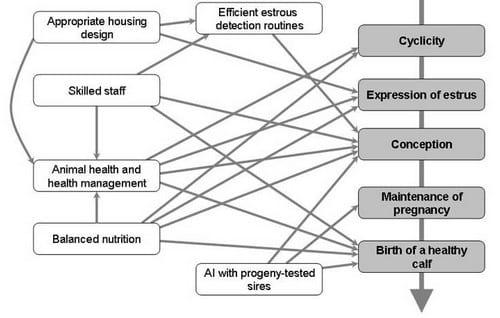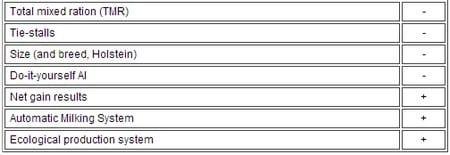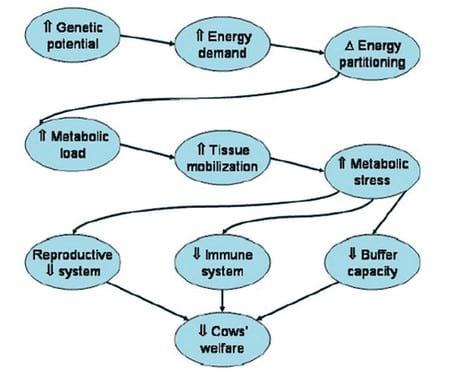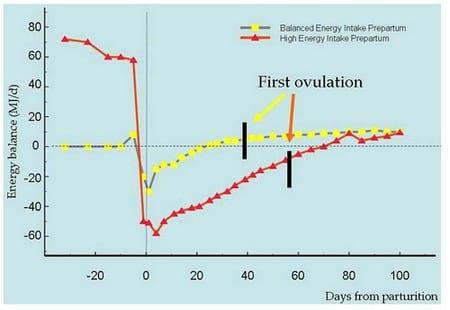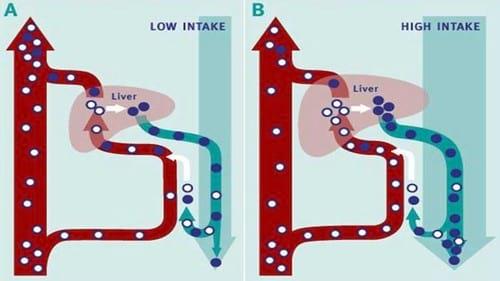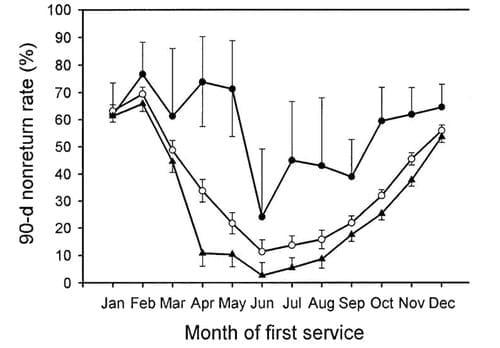1,3,4Division of Reproduction, Dept of Clinical Sciences, Faculty of Veterinary Medicine and Animal Science, Swedish University of Agricultural Sciences, Uppsala, Sweden. 1,2,5,6,7,8,9Dept of Animal Environment and Health, Faculty of Veterinary Medicine and Animal Science, Swedish University of Agricultural Sciences, Skara, Sweden. 10Division of Ruminant Diseases and Epidemiology, Dept of Clinical Sciences, Faculty of Veterinary Medicine and Animal Science, Swedish University of Agricultural Sciences, Uppsala, Sweden. 11,12Dept of Animal Breeding and Genetics, Faculty of Veterinary Medicine and Animal Science, Swedish University of Agricultural Sciences, Uppsala, Sweden. 6,13,14,15VikingGenetics, Örnsro, Skara, Sweden. 16Swedish Dairy Association, Stockholm, Sweden.
Metabolic Load During Lactation, Health and Welfare in High-producing Dairy Cows
In dairy cattle, metabolic load (ML) is defined as "the total energy burden imposed by the synthesis and secretion of milk, which is met by mobilization of body reserves", while MS is defined as "the amount of ML that can not be sustained by this mobilization, leading to the down-regulation of some energetic processes, including those that maintain general health". In high-genetic-merit cows, selected for high milk yield, there is an increased body-tissue mobilization and an increased ML which, in some of these cows, can be reflected by a period of marked NEB during early lactation, compared to cows of average genetic merit. Cows in NEB down-regulate their own protein synthesis owing to a shortage of amino acids from the diet, while they mobilize their tissue fat to maintain, or even increase, the secretion of milk fat. Energy balance begins to decrease during the last few weeks prior to calving primarily due to a 30 - 35% reduction in voluntary feed intake. Moreover, after calving, the mobilization of body reserves and the volume of milk secretion increase much faster than the voluntary feed intake. Cows typically remain in NEB for 5 - 7 weeks postpartum. Typical energy curves for a high-producing dairy cow are depicted in Fig. 13, showing the association of lactation and energy demands of the postpartum dairy cow.
Figure 13. Energy (in Mcal/day) curves (feed, milk production and body stores) for a lactating, high-producing dairy cow, in relation to time in lactation (trimesters) and breeding period

The mobilization of body reserves during the period of lactational NEB is a key factor for disease susceptibility in dairy cattle. The ability to store reserves, as subcutaneous fat, differs. For instance, Holstein cows have a thinner layer of subcutaneous fat compared to Swedish Red. The NEB relates negatively to metabolic and locomotor disorders, such as milk fever, ketosis and laminitis. Because high-producing dairy cows, in order to maintain a good body condition (BC), have to spend a large part of the day and night eating and ruminating instead of performing other behaviours like grooming, exploring, interacting socially, or displaying sexual behaviour, NEB also affects behaviour negatively. When cows perceive their situation as stressful and they can not cope with it, abnormal behaviour follows. Cows with an active coping pattern display tongue-rolling, head-leaning, muzzle-pressing and self- or inter-suckling, whereas cows with a passive coping pattern become more inactive, which could cause a reduction in feed intake.
High milk production per se does not always elicit negative effects on health and fertility traits, and the effect seems to depend on the farm and production environment. Relationships of housing, management and nutrition with fertility are described in Fig. 14 and a summary of the influence of some management factors in modern dairy is given in Table 2. Actually, increases in herd size and use of loose-housing systems, while promoting the expression of estrous signs and advancing the interval to 1st ovulatory estrus (Table 3), have led to increased incidences of some production-related diseases, including lameness, which has reached >20% incidence risk during lactation. Some of the several causes for lameness relate to ML. For instance, and probably owing to stress-driven endocrine modifications, lame cows have reduced milk yield, decreased reproductive performance, and an increased risk of being culled.
Figure 14. Relationships of housing, management and nutrition with dairy cow fertility
Table 2. Management influence (positive or negative) on dairy cattle fertility. Swedish data including 2708 farms with >45 cows incorporated in the national cow monitoring system between September 2004 and August
Table 3. Effect of housing on the onset of postpartum (p.p.) estrus in dairy cattle

The incidence of sole ulcers, an important cause of clinical lameness, is influenced by dietary levels, floor type, reproductive stage, cow conformation and genetics (reviewed by and clearly affects reproductive performance, udder health, milk yield, and culling. This calls for an increased detection of early lameness by e.g., automated kinematic analysis and the use of better flooring systems (soft floors with friction). The latter not only prevent claw and leg problems but also enhances proper signaling of estrus and other behaviour. The environment should also be conducive to high voluntary feed intake, taking into consideration that cows with higher LW at lactation (usually those of higher milk yields) are supposed to be able to eat as much as they can, although their appetite and the size of their rumen are limited. As mentioned below, cows that are fat (high BC score) at calving usually eat less during lactation and sink into a deeper NEB, marking the importance of applying feed restrictions during the dry period. Cows need time and space for undisturbed feeding and rumination and react negatively if they need to compete for feeding space. Convincing evidence reveals now that the design of food passages, barriers and water troughs, as well as cow traffic within the building, affect the voluntary intake level of cows. Transfer and re-grouping of cows challenge their social behaviour, and the energy spent to establish a new social hierarchy is no longer available to produce, or reproduce. In accordance with the resource allocation theory, the animals´ resources are optimally allocated to different biological processes to maximise the animals´ fitness. Animals that have been selected for high production, including the dairy cow, may reallocate more of their resources into production traits and as a result to use less energy demanding behaviours which will reduce the animals´ capacity to cope with stressors such as the establishment of a social hierarchy or adapting to an unpredictable environment. It seems obvious that a plethora of linked biological events mediate the unfavourable consequences of selection for increased milk production on the welfare of high-producing dairy cows, as outlined in Fig. 15.
Figure 15. Interactions between biological events mediate the unfavourable consequences of aggressive selection for milk production on the welfare of high-producing dairy cows
Why is the Cow Sub-fertile During Lactation? Interaction Between Genetic Selection for Milk Production and Management
Studies on reproductive data from Holstein heifers have indicated that their CRs are significantly higher compared with 1st-lactation cows, marking the antagonistic relationship between lactation and reproduction. Lactational NEB compromises fertility because the time needed to recover from NEB acts as a metabolic modulator (restrainer) of the initiation of postpartum ovarian activity and of the behavioural display of estrous signs. The high-producing cows of today have shorter estrous cycles, display fewer standing estruses, show estrus of shorter duration (Table 1 and Fig. 12), and often present double- or multiple ovulations. In the worst-case scenario, they are simply anestrous. Apparently, the reduced expression of insulin-growth factor binding protein-2 (IGFBP-2) mRNA in severe NEB cows might alter the bioavailability of circulating insulin-like growth factor (IGF-I) and of locally-produced IGF-II to modulate the pre-recruitment stages of follicles required to maintain normal postpartum ovarian cyclicity. Moreover, NEFA released from the adipose tissue during NEB accumulates in the follicular fluid and disturbs follicle development. Plasma IGF-I concentration in early lactation is, alongside with milk protein content, a useful indicator of reproductive efficiency. Table 4 summarizes some of the metabolic, endocrine and functional/clinical reproductive changes occurring as a consequence of ML and of NEB in high-producing dairy cows.
Table 4. Metabolic load (ML) causes negative energy balance (NEB) and increases metabolic rates impairing reproduction in lactating, high-producing dairy cows

However, we need to remember that the cause of low fertility in dairy cows is multi-factorial, not only originated by lactational NEB. Poor nutritional management of the dairy cow, particularly before and after calving, is actually a key driver for infertility owing to the intricate relationships between nutrition intake and hormonal pathways in dairy (Fig. 16). As we have already mentioned, reproductive traits have low heritability (<5%), so a major part of the documented decline in reproductive performance can be attributed to commercially-driven changes in the dairy sector such as larger herds, housing changes and tying procedures, DIY-AI, use of TMR, etc, that make harder to properly manage the reproduction of the cows. For instance, use of TMR during the dry period leads to a large variation in BC, which is latter reflected in decreased fertility. A clear decrease in fertility can also be seen after DIY-AI (compared to trained AI-technicians), a matter of major concern for the need of more training, and advice, but also because some of these changes are causing problems of detection and (even worse) the intensity of display of estrous signs. There is a strong global trend towards larger dairy herds and automatization of e.g., feeding and milking in most industrialized countries. This trend is accompanied by shorter times for supervision and care of the individual animal, and an increased use of hired and often inexperienced short-term labor, often resulting in deteriorated reproductive management and fertility (Table 2 and Table 3). Laborious estrus detection and poor conception rates have led to AI being replaced by natural services using cheap, untried bulls for returning cows, thus neglecting the advantages of AI and breeding selection. In North America and some European countries, mainly Scandinavia, the Baltic region, Austria and Switzerland, where a substantial part of the herds are still kept tied, there is a simultaneous trend towards loose housing in free-stalls, resulting from animal-welfare concerns and rationalization. The transition has a potential to facilitate behavioral expression of estrus and estrous detection. On the other hand, inferior barn design, limited space and low quality of flooring of alleys, passageways and holding areas have constrained the cow´s ability to display estrus by affecting their locomotion and deteriorating claw health, further reducing reproductive performance (Fig. 14).
Figure 16. Relationships between nutritional intake and hormonal pathways in dairy cattle
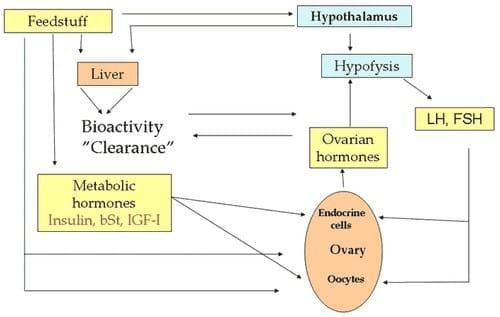
A poor BC at calving has a significant negative impact on the probability of conception, the rate of embryonic loss, and the proportion of anestrous animals (33). Poor nutrition during the dry- and early postpartum periods results in reduced glucose, insulin, IGF-I and low LH pulse frequency with concomitant increases in beta-hydroxybutyrate (BHB), non-esterified fatty acids (NEFA) and triacylglycerol. Already at this stage, cows must mobilize large lipid reserves, but also some protein reserves, increasing the incidence of metabolic disorders like milk fever, acidosis, ketosis, fatty liver and displaced abomasum. Occurrence of milk fever and ketosis affect uterine contractions, delay calving and increase the risk of retained fetal membranes (RFM) and development of endometritis. Fat and/or overfed cows at calving (high BC) are those becoming problem cows when NEB is established (Fig. 17), implying that a high BC at calving is actually considered to be worse than a low BC, because high BC-cows eat less after parturition, have lower appetite, easily mobilize energy from body reserves, thus being more prone to suffer dramatic changes in BC. Moreover, a high BC appears to be one of the nutritional risk factors causing RFM, alongside with hypocalcemia and deficiencies in vitamin E and selenium; metabolic disorders which, in turn, predispose cows to gynecological pathologies, of which endometritis postpartum is most important. Risk factors for endometritis postpartum are thus hypocalcemia, RFM, high triacylglycerol and NEFA levels (Fig. 18). In sum, cows that are able to maintain the same BC (either low or high) manage better than those having fluctuating BC.
Figure 17. Overfeeding dairy cows pre-partum delays the occurrence of spontaneous first ovulation postpartum
Figure 18. Risk factors (as Odd Ratios, OR) for endometritis in postpartum dairy cattle

Cows that are over-conditioned at calving or that loose excess body weight (BW) are more likely to have a prolonged interval to 1st-estrus, thereby increasing the number of days open (DO). Recent evidence shows that dry matter intake (DMI) is the principal component of NEB influencing subsequent fertility. Nutritionally-induced postpartum anestrus is characterized by a turnover of dominant follicles incapable of producing sufficient estradiol to induce ovulation due to a reduced LH pulse frequency. Lower concentrations of estradiol on the day of estrus are highly correlated with the occurrence of sub-estrus, thereby making the detection of estrus in high-yielding cows even more difficult. Nutrition also affects CR at following AI. Cows that develop hypocalcaemia, ketosis, acidosis or displaced abomasums have lower CRs and take longer time to become pregnant. Excessive loss of BC and excess protein content in the ration can reduce CR while supplementation with certain fats increase progesterone (P4) concentration in blood plasma, attenuates the production of PGF2α, and can lead to an increased CR. The increased metabolic clearance rate of P4, which decreases blood concentrations during early embryo cleavage up to the blastocyst stage is associated with decreased CR. High nutrition levels can also increase the metabolic clearance rate of steroid hormones such as P4 or estradiol (see Fig. 19).
Figure 19. Effect of a high feed intake on the metabolism/clearance of estradiol (E2)
E2, circulating in the blood stream, is normally inactivated in the liver by conjugation and excretion through the bile. In the intestine, bacteria re-activate the E2 which is resorbed via the mesenteric blood stream and returned to the liver. At low feed intake (A), less E2 is transported to the liver via the mesenteric blood pathway and thus the total E2 metabolic rate is low. When feed intake increases (B) or it is high in large, high-producing dairy cows, the mesenteric blood flow increases and more E2 reaches the liver, which increases in size to meet demands for the elimination of E2, thus decreasing its levels in the animal with consequences for normal signalling during estrus (e.g., poorer estrus signs).
Genetic merit for high milk production often leads, over the year, to reduced reproductive performance in comparison to cows with medium- or low-genetic merit, as it has been determined for Holstein cows in southern USA (Fig. 20). However, other studies have not detected associations between reproductive performance and milk production, feed intake or plasma concentrations of glucose, NEFA or IGF-I between calving and 1st-service, calling for caution when promoting these variables as predictors of reproductive performance.
Figure 20. Seasonal variation in 90-d non-return rate (least-squares means ± SEM) to first service is affected by ECM milk yield (• <4536 kg; o = 4536-to-9072 kg; ? > 9072 kg)

